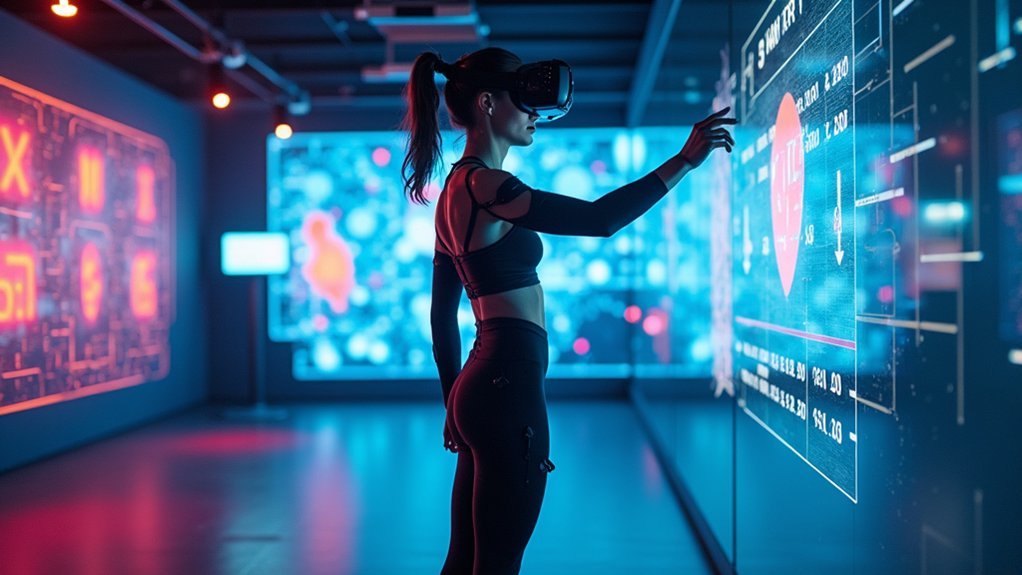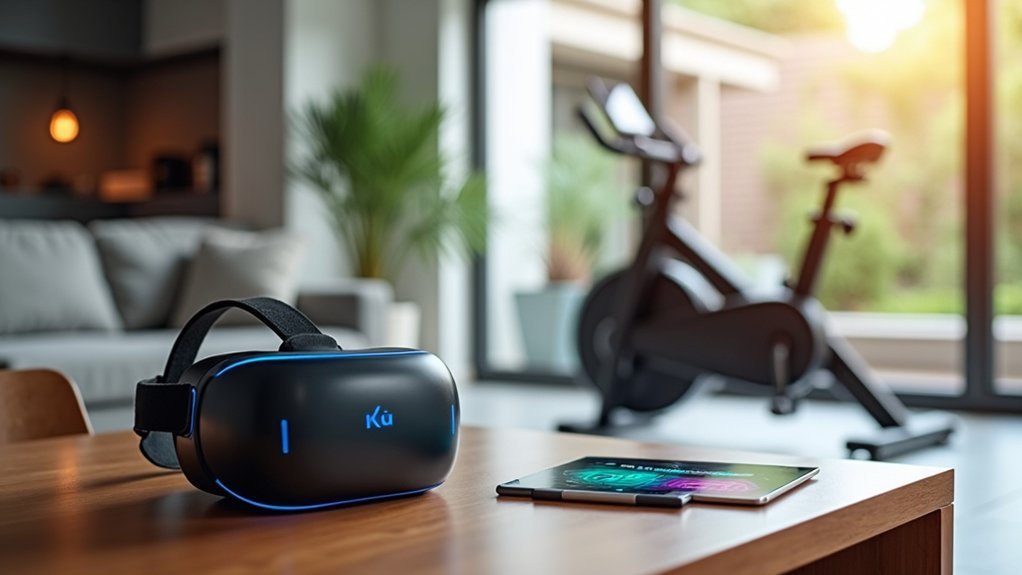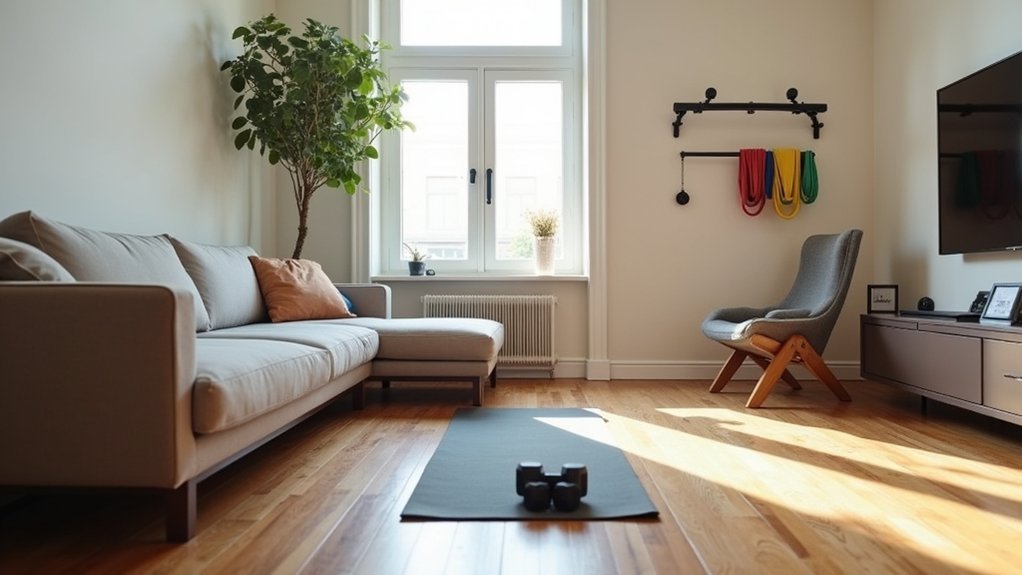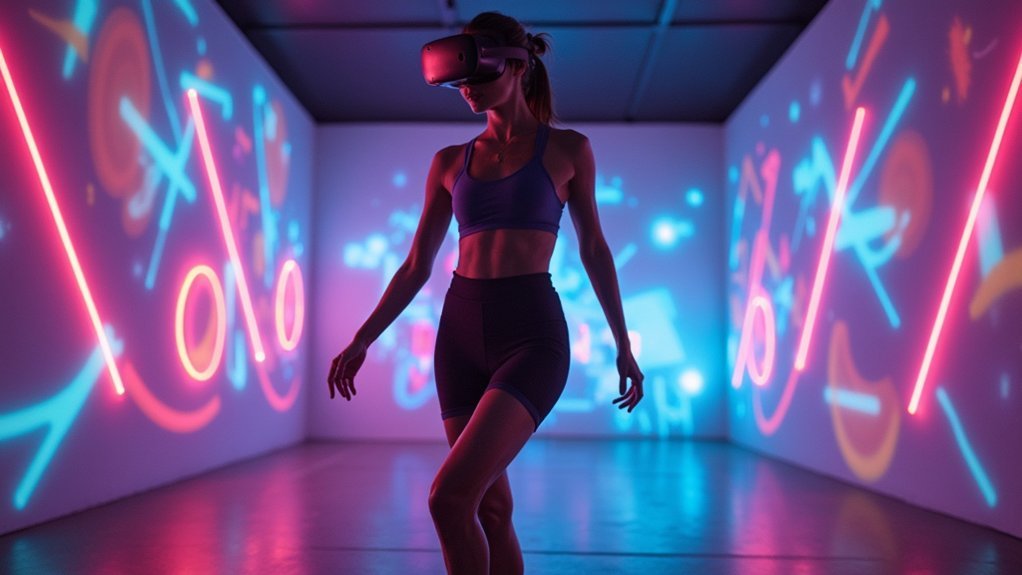When choosing VR fitness technology, prioritize sensor accuracy within 3mm for proper form tracking and controllers with under 90ms latency for responsive workouts. Inside-out tracking offers convenience for casual sessions, while external camera systems provide superior precision for form-focused exercises. Confirm your space meets the minimum 2m x 1.5m requirement, and consider full-body tracking options like HTC VIVE or SlimeVR for thorough feedback. The right tracking system can transform your virtual workouts into tangible physical results.
Evaluating Sensor Accuracy for Proper Form Tracking
When evaluating VR fitness technology, sensor accuracy stands as the foundation for effective form tracking and feedback.
Look for systems offering static accuracy within 3mm and sub-degree rotational precision, as these provide reliable form correction.
Consider movement constraints—tracking loss increases considerably at higher speeds, with errors reaching 34% at 900 mm/s. You’ll get the best results keeping movements under 135 mm/s where tracking loss drops below 0.5%.
Speed matters for accurate VR fitness tracking—movements under 135 mm/s maintain error rates below 0.5%, while rapid motion can cause significant data loss.
Prioritize HMDs for the most reliable tracking, followed by controllers, with body trackers showing the lowest accuracy. The Vive Tracker 3.0 offers a good balance of accuracy and practicality for full-body integration.
Don’t overlook proper calibration and base station arrangement, as these considerably impact tracking precision and can eliminate preventable errors.
Comparing Inside-Out vs. External Camera Tracking Systems
Choosing between inside-out and external camera tracking systems greatly impacts your VR fitness experience.
Inside-out systems offer convenience with embedded headset cameras that require no additional setup, making them portable and cost-effective for beginners or casual users.
However, if you’re serious about fitness form tracking, external camera systems provide superior accuracy and spatial awareness, especially in larger workout spaces. They’ll capture movements more precisely but come with higher costs and setup complexity.
Consider your fitness goals: inside-out tracking works well for general workouts where approximate movement detection suffices, while external cameras excel for exercises requiring precise form monitoring. For the most comprehensive workout variety, look for systems compatible with popular fitness apps like Supernatural and FXR, which offer diverse workout options for different fitness levels.
Also factor in your space constraints, technical comfort level, and budget when deciding which tracking system will best support your VR fitness journey.
Full-Body Motion Capture Options for Comprehensive Workouts

Why limit your VR fitness experience to just hand controllers when full-body motion capture can transform your entire workout? These systems track multiple body points simultaneously, providing thorough feedback on your form and performance while revealing more immersive exercise experiences.
Break free from controller limitations—full-body tracking revolutionizes VR workouts with multi-point feedback and immersive exercise experiences.
- IMU-based systems like SlimeVR offer affordable entry points with sensors that attach to key joints, though they require more frequent calibration during dynamic movements.
- Premium trackers such as HTC VIVE Ultimate Tracker provide superior accuracy and reliability with SteamVR compatibility, ideal for serious fitness enthusiasts.
- Combination setups with waist and ankle trackers deliver enhanced precision for varied workout positions including floor exercises.
When choosing your system, consider wireless capabilities, battery life, and compatibility with your favorite fitness apps to guarantee seamless integration into your routine.
Hand Controller Precision and Response Time Considerations
Precision and responsiveness form the backbone of an effective VR fitness experience. When selecting controllers for your workout apps, prioritize options with latency below 90ms, especially for unpredictable motion exercises.
For fast-paced fitness games, look for controllers featuring the latest firmware updates, like Meta Quest’s Hand Tracking 2.2, which reduces latency by up to 75% during rapid movements.
Consider whether your workout involves predictable motions (tolerating up to 130ms latency) or unpredictable changes requiring quicker responses.
Evaluate tracking confidence metrics and filtering technologies that minimize jitter. Remember that cloud-based VR workouts introduce additional latency, so opt for local processing when possible.
Controllers with higher sampling rates and Fast Motion Mode features will greatly enhance your performance in high-intensity VR fitness routines.
Space Requirements and Room-Scale Tracking Capabilities

When setting up your VR fitness environment, adequate physical space becomes just as essential as the technology itself.
Space isn’t just a VR luxury – it’s a fitness necessity equal to the headset itself.
You’ll need at least 2m x 1.5m (6.5ft x 5ft) for comfortable room-scale experiences, though larger areas enhance immersion and allow for more dynamic workouts.
Your tracking system choice will determine how accurately your movements translate to VR.
External sensors (like those used by HTC Vive) require careful placement around your space, while inside-out tracking systems (like Oculus Quest) offer more flexibility but may have limitations.
- Ensure obstacle-free space to prevent injuries during vigorous activities
- Consider ceiling height for jumping exercises and full-range movements
- Install floor padding for high-impact workouts to protect joints and equipment
Motion Tracking Integration With Fitness Performance Analytics
The foundation of effective VR fitness experiences lies in how accurately your movements translate into meaningful data. When selecting a VR fitness system, prioritize solutions that combine motion tracking with thorough analytics platforms that process your movements into actionable insights. The most advanced systems utilize the six degrees of freedom concept to ensure comprehensive tracking of all possible movement types during workouts.
| Analytics Feature | Benefit to You |
|---|---|
| Real-time form feedback | Prevents injuries and maximizes exercise effectiveness |
| Progress visualization | Keeps you motivated by showing improvement over time |
| Biometric integration | Connects movement data with physiological responses for complete fitness picture |
Look for systems that pair high-fidelity tracking with intuitive data visualization. The best platforms detect subtle movement patterns while minimizing latency, offering personalized workout adjustments based on your performance. This integration transforms random VR activity into structured, progressive training that adapts to your unique needs.
Frequently Asked Questions
Does VR Fitness Actually Help With Weight Loss?
Yes, VR fitness can help with weight loss. You’ll burn calories through engaging exercises, and you’re more likely to stick with it because it’s enjoyable and motivating compared to traditional workouts.
Can VR Fitness Replace Traditional Gym Memberships?
VR fitness can replace traditional gyms for cardio and casual workouts, but you’ll miss out on heavy strength training. It’s more convenient and often cheaper long-term, though you’ll need appropriate space at home.
How Do I Prevent Motion Sickness During VR Workouts?
Try ginger supplements before workouts. Focus on fixed points while exercising. Don’t use VR after eating. Keep your space cool with good airflow. Start with brief sessions and gradually increase your exposure time.
Are VR Fitness Platforms Suitable for Seniors or Beginners?
Yes, VR fitness platforms are well-suited for seniors and beginners. You’ll find specially designed programs with safety features, user-friendly interfaces, and adaptable difficulty levels that make exercise both accessible and engaging for your needs.
What’s the Optimal Workout Duration to Avoid VR Fatigue?
Limit your VR workouts to 30-60 minutes per session to avoid fatigue. You’ll get the best results by taking breaks every 15-30 minutes and stopping immediately if you experience dizziness, nausea, or eye strain.
In Summary
When choosing VR fitness technology, you’ll need to prioritize sensor accuracy, tracking systems, and motion capture options that suit your workout style. Don’t overlook controller precision and response times, as they’ll affect your experience. Make sure you’ve considered your available space and room-scale tracking needs. Finally, look for solutions that integrate motion tracking with fitness analytics to maximize your progress and results.





Leave a Reply